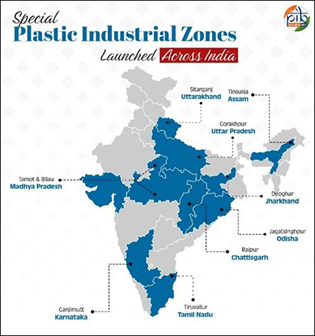Economy
Insider trading:
-
- It is when a breach of a fiduciary duty or other relationship of trust and confidence happens in trading a security (for example, a stock) based on non-public information that only a few people are privy to.
Silk production in India:
-
- Sericulture is process of farming silkworms to make silk.
- Silkworms are raised on mulberry, oak, castor, and arjun leaves. After about a month, they spin cocoons. These cocoons are collected and boiled to soften silk. Silk threads are then pulled out, twisted into yarn, and woven into fabric.
- India is the second largest producer of silk and also the largest consumer of silk in the world.
- In India, mulberry silk is produced mainly in the states of Karnataka, Andhra Pradesh, Tamil Nadu, Jammu & Kashmir and West Bengal, while non-mulberry silks are produced in Jharkhand, Chattisgarh, Orissa and north-eastern states.
- Mulberry silk comes from silkworms that eat only mulberry leaves. It is soft, smooth, and shiny with a bright glow, making it perfect for luxury sarees and high-end fabrics.
- 92% of the country’s total raw silk production comes from mulberry.
- Non-mulberry silk (also known as Vanya silk) comes from wild silkworms that feed on leaves from trees like oak, castor and arjun. This silk has a natural, earthy feel with less shine but is strong, durable, and eco-friendly.
Indian Polity & Governance
Panchayat Advancement Index (PAI):
-
- The government’s inaugural Panchayat Advancement Index (PAI) was launched on April 9, 2025, ranking over 2.16 lakh panchayats based on their performance and progress towards achieving Sustainable Development Goals (SDGs).
- According to Ministry of Panchayati Raj (MoPR), it is a multi-dimensional index used to assess the implementation of Localization of Sustainable Development Goals (LSDGs) across nine broad themes. Under these brackets, performances on 144 targets were measured.
- Panchayats were then scored on a scale of 0-100 based on these indicators and ranked in one of five categories: Achiever (90-100), Front Runner (75-90), Performer (60-75), Aspirant (40-60) and Beginner (below 40).
- Of the 2.16 lakh panchayats, 699 have been ranked as Front Runners, 77,298 as Performers, 1,32,392 as Aspirants, and 5,896 as Beginners.
- Of the 699 panchayats ranked as Front Runners, 346 are from Gujarat, followed by Telangana (270) and Tripura (42). None of the panchayats has been ranked in the Achievers (90-100) category.
Geography/Places in the news
Rivers between U.S and Mexico:
-
- S. President Donald Trump threatened Mexico with “escalating consequences” on trade unless it provides more water to Texas under a contentious decades-old treaty.
- He claimed Mexico was violating a 1944 pact under which the U.S. shares water from the Colorado River in exchange for flows from the Rio Grande, which forms part of the border between the two countries.
Colorado River:
-
- Major river of North America, rising in Rocky Mountains of Colorado, U.S., and flowing generally west and south for 2,330 kilometres into Gulf of California in northwestern Mexico.
- For 27 km, the river forms the international boundary between the U.S. state of Arizona and Mexico.
- It forms Grand Canyon, Marble Canyon, Glen Canyon, and Cataract Canyon.
- To the downstream, it is flanked by two great deserts, the Mojave and the Sonoran.
- Hoover dam creates Lake Mead across river.
Rio Grande:
-
- Fifth longest river of North America, forming the border between the U.S. state of Texas and Mexico.
- Rising as a clear, snow-fed mountain stream more than 3,700 metres above sea level in the Rocky Mountains, Rio Grande descends across steppes and deserts, watering rich agricultural regions as it flows on its way to Gulf of Mexico.
History, Art & Culture
Mahatma Jyotiba Phule:
-
- Born on April 11, 1827, in the Mali caste.
- Phule and his wife Savitribai cofounded the first school for girls in India in 1848.
- By 1855, Phule had also opened night schools in Pune, intended as a centre of learning for workers, farmers, and working women who were busy during the day.
- In his later years, Phule had vociferously opposed first Vishnu Shashtri Chiplunkar, and then his protege Bal Gangadhar Tilak.
- Phule preferred to work with the British government to improve conditions of untouchables and depressed castes and emancipation of women, while Tilak and other orthodox nationalists saw the British government as an occupying force intent on changing what they felt was the fundamental character of the Hindu religion.
- Phule also founded the Satyashodhak Samaj (Society of Truth-Seekers) in September 1873.
- Books – Gulamgiri (Slavery), Satsar (The Essence of Truth), Shetkaryanche Asud (Farmer’s Whip).
- He was also inspired by Thomas Paine’s Age of Reason.
- His ideology – Rational thinking and secular view, criticised caste system, advocacy of women’s rights, widow remarriage, social justice, universal values of dignity, equality & justice.
Science & Technology
-
- Defence Research and Development Organisation successfully conducted release trials of the 1,000-kg long-range glide bomb ‘Gaurav’ from a Su-30 MKI fighter jet.
- The trials successfully demonstrated range close to 100 km with pin-point accuracy.
- It is designed and developed indigenously by Research Centre Imarat, Armament Research and Development Establishment and Integrated Test Range, Chandipur.
Government Schemes
-
- Scheme for Setting up of Plastic Parks:
- Department of Chemicals and Petro-Chemicals is implementing the Scheme for Setting up of Plastic Parks under the umbrella scheme of New Scheme of Petrochemicals, to support setting up need-based Plastic Parks, with requisite state-of-the-art infrastructure, enabling common facilities through cluster development approach, to consolidate the capacities of the domestic downstream plastic processing industry.
- Under the scheme, the government of India provides grant funding up to 50% of the project cost subject to a ceiling of Rs.40 crore per project.

PRACTICE MCQ’S
Q1. Which of the following statements about Jyotirao Phule are correct?
1. He and his wife founded the first school for girls in India in 1848.
2. He opposed the views of Bal Gangadhar Tilak and preferred to work with the British government to improve conditions of untouchables and depressed castes.
3. He founded the Satyashodhak Samaj (Society of Truth-Seekers) in 1873.
4. He was inspired by Thomas Paine’s Age of Reason.
Select the correct answer using the code given below:
a) 1 and 3 only
b) 1, 2 and 3 only
c) 1, 3 and 4 only
d) All of them
Answer: D
Q2. Consider the following statements about ‘Setting up of Plastic Parks’ scheme:
1. It is implemented by Department of Chemicals and Petro-Chemicals under the umbrella scheme of New Scheme of Petrochemicals.
2. Under the scheme, the government of India provides grant funding up to 80% of the project cost subject to a ceiling of Rs.40 crore per project.
Which of the statements given above is/are correct?
a) 1 only
b) 2 only
c) Both 1 and 2
d) Neither 1 nor 2
Answer: A
Q3. Which of the following rivers form an international border between the U.S and Mexico?
a) Colorado and Rio Grande
b) Mississippi and Rio Grande
c) Colorado and Mississippi
d) Rio Grande and Tennessee
Answer: A
Q4. Consider the following statements about the silk production in India:
1. India is the second largest producer of silk in the world.
2. About 90% of the country’s total raw silk production comes from mulberry silk.
3. Andhra Pradesh is the leading producer of silk in India.
Which of the statements given above is/are correct?
a) 1 only
b) 1 and 2 only
c) 2 only
d) 3 only
Answer: B
Q5. Consider the following statements regarding Panchayat Advancement Index 2025:
1. It is introduced by the Ministry of Panchayati Raj.
2. It assesses the implementation of Localization of Sustainable Development Goals (LSDGs) in Panchayats across five broad themes.
Which of the statements given above is/are correct?
a) 1 only
b) 2 only
c) Both 1 and 2
d) Neither 1 nor 2
Answer: A
Download pdfSpread the Word

